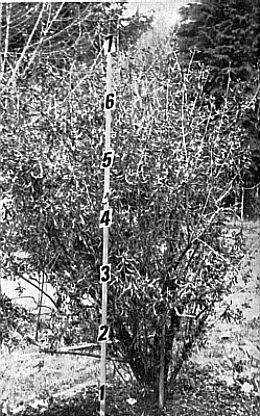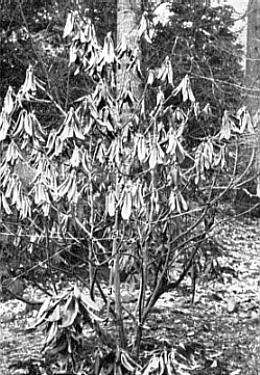QBARS - v27n4 Observations on West Coast Rhododendron Damage
Some Observations on Rhododendron Damage on the West Coast
Six Months After the Record-breaking Cold of December 1972
Dr. Carl H. Phetteplace, Eugene, Oregon
Reports on cold damage suffered along the West Coast from San Francisco to Seattle have been so widely and well covered in the April 1973 Bulletin that further comments might seem tiresome. As six months have passed since this unprecedented climatic prank there are already some agreeable surprises in my garden that have taught me much and may be of some interest to others.
As a preliminary it might be well to review some of the conditions related to the cold and its effects. The preceding summer was delightfully warm and pleasant with, at one time in the Eugene area, a record temperature of 106° F. being recorded. During the calendar year almost five feet of rainfall was recorded. On Thanksgiving Day our hanging baskets of fuchsias about the patios were the most beautiful they had ever been, despite four frosts in the few weeks before to about 30° F. This was welcome as it should initiate a state of dormancy which by now was needed in preparation for winter. Evidence that this did indeed induce some degree of dormancy is that this year there has been almost no bark split observed while in some years there has been considerable bark separation after relatively mild frosts in September or in February after a period of rather premature warm spring-like weather.
The minimum temperature registered here was -6° F. occurring after the previous night having been cold enough to freeze the ground an inch or two deep. A fine powdery snow began falling on the frozen ground and continued 24 hours until about one foot was accumulated. This remained and, for a week after, sub-zero temperatures continued nightly with days always still below freezing. There was no wind, but the powdery snow did not protect the shrubs as much as the heavy wet snow we usually have which bears branches down and covers them better. I had used no fertilizer for the past few years and had done no irrigating since September, but the ground and shrubs were not at all dry. In late March I toured the garden appraising and tabulating the damage as best I could. Many plants were completely defoliated or leaves hung brown and dry, quite dead. Generally I sampled the cambium layer by chipping a bit of bark off with a knife. A dark brown cambium layer to the ground especially with dead foliage seemed ample evidence to consider a plant killed.
I have a list of about 170 species with as many or more hybrids so checked.
Subsequently I have checked the garden at different times and find considerable changes from my earlier appraisals, especially due to the changes that have occurred the first two weeks in June. It is these findings that have been most interesting. In this area we have never before seen rhododendrons' reaction to such weather so these observations have taught me much.

|
|
FIG. 43. Although it appeared comp-
letely dead on April l, R. davidsonianum white form, had begun to regenerate from the base by June 15, 1973. Photo by Dr. C. H. Phetteplace |

|
|
FIG. 42.
R. falconeri
, with 150 buds,
had reached 12 feet in 25 years. Extreme temperatures of December, 1972 killed the plant in the Phetteplace garden. Photo by Dr. C. H. Phetteplace |
1. Neither a dark brown cambium layer or complete defoliation are criteria of a dead plant so long as the bark is not badly split or detached. Some such plants have now sent out dozens of small green sprouts all along the bare branches.
2 Large mature plants do not necessarily endure the cold better than smaller ones of the same variety. A R. barbatum with a 6inch trunk near the ground is completely dead. The smooth Madrona-like bark has no dormant growth buds. Nearby a four-year-old cutting of this plant which has not yet developed the smooth mature bark has sent out numerous green sprouts below the snow level. There are several other such examples. Of course plants so small- even Maddeniis - as to be completely covered with snow survived.
3. It is not true that varieties with smooth Manzanita-like bark never have dormant growth buds to break out if the top is cut back. A number of species such as R. glaucophyllum, campylogynum, ciliatum and moupinense and its hybrids have sent out new shoots from below the snow cover, though being quite dead above. Conversely, some rough-barked varieties, especially in larger plants, have never forgiven the insult. One that surprised me especially was a large plant of R. 'Azor.' It is thoroughly dead.
4 On examining the cambium layer on some plants in which this tissue earlier was dark brown or even black there is in June some noticeable 'greening" taking place. It appears that in some instances a thin new cambium layer is developing beneath the dark one, but in all cases, except the obviously dead ones, there is less dark color to this layer than last March. These plants are showing signs of rejuvenation such as green sprouts or evidence of new leaf formation.
5. There is a suggestion that hybridization may increase hardiness. Several hybrids seem to have come through better than either of their relatively tender species parents.
6. One should never destroy a plant no matter how frozen-to-death it may appear in April. The plant, if worth keeping at all, should be left for a full year before giving it up. If a large plant, completely dead in appearance, so mars the landscape as to impel you to do something, it may be cut off 2 feet above ground level and its cut surface painted at once with a plastic sealer or paint. Where this was not done great quantities of sap have oozed from the stump in some cases with the advent of warm spring days. Such a plant possibly could have been saved.
Many friends about the country have written or phoned condolences to me about my losses as if I had lost a loved one. I am most grateful for this kind thoughtfulness and sympathy. Really I have not been "wiped out" as some feared. It is not the number of plants killed that has hurt. It is the particular special, and often irreplaceable plants ruined that is most grievous. This includes a 45-year-old red R. barbatum , a 15-foot R. falconeri heavily budded, a 16-foot 'Sir Charles Lemon', a 10-foot budded R. macabeanum (plus several smaller ones) all the big-leafed plants from the Rock 1948 expedition which were 25 years old, and others hard to come by. The Rock specimens included several Falconeri series plants (possibly Sino-falconeri) not grown elsewhere that I know of, several plants each of R. coriaceum , R. fulvum , R. praestans and others. Out of four Dr. Rock R. crinigerum introductions only one remains. Others which in June seem quite dead are R. eximium , R. mollyanum , R. rex , R. arizelum , all Irroratum series and others. Somehow they grew here for years when they were not successful for the most part in other Oregon and Washington gardens.
In March most of the Triflorum series and sub-series were often defoliated and with dark cambium layers and even brittle twigs. This was also true of some other series such as Cinnabarinum, Glaucophyllum of various forms, Arboreum, Boothii and others. It has been quite surprising to see green shoots coming from a number of these during the first two weeks of June. Of course there is the real possibility that a plant may put out new growth this year and fade away by next year because of loss of cambium layer.
Most members of the Fortunei series and their hybrids have been little damaged. R. fargesii has never been so beautiful before. There were no casualties in the Ponticum series, R. wardii (several plants and forms) did quite well. Campanulatum series were never better. All Taliense series plants were unscathed. This group impresses me more each year. If only my father or grandfather had planted them here so I could now see them in flower along with their beautiful foliage.
No native American azaleas or rhododendrons were injured in any way, including our native R. occidentale often considered too tender for the East Coast.
A thought has occurred to me: Can some relatively tender varieties eventually become inured to colder climates under certain conditions? Once I sent seeds of our relatively tender Oregon maple - Acer macrophyllum - to a person who lives where winter temperatures always go to -20° F. or lower. He reports that each year they froze to the ground, but grew well again next summer. After this was repeated about four winters these maples now go through the winters with no trouble. A red R. arboreum I've had for 35 years has now frozen to the ground three times. This year it was 10 feet tall when cut back. Again many green shoots are coming up from ground level. For two years past it has had undamaged trusses. The same is true of R. sidereum though it has never flowered. This could not be hoped for with many tender varieties which have no tendency to break out from below. Some rhododendrons at least inherently resist threats to their existence and will not die.
One more question has come to mind. Should we take the risk of growing such species series as Grande, Falconeri, Maddenii, Irroratum and others in our Species Foundation garden in the Willamette valley as the only place? Many of these are quite spectacular, rare, and have been obtained at cost of considerable effort not to mention expense. If such a winter occurred only once in 25 or 50 years it would be too often to be caught with all our "eggs in one basket." Some of these plants do not reach their real flowering beauty before 25 years. Previously I have suggested at one of our Species Foundation meetings consideration be given to an "annex" to the Species Foundation garden near Salem in such an area as San Francisco Bay region where duplicates of these varieties could be grown with a greater safeguard against being "wiped out."
The check-list I am keeping on several hundred plants is too long and perhaps uninteresting to publish in the Bulletin, but may be more useful to the Book Committee when reviewing their hardiness ratings.
Despite the loss of all these "darlings", we have had a beautiful garden this spring. The hardy species such as Dauricum series, many of the Fortunei family, members of the "little people" like Lapponicums, the Knaphill and Exbury and native American azaleas and many hybrids (especially 'P.J.M.'!) have been a joy.
I already have obtained a new 30 inch plant of R. macabeanum F.C.C. Rhododendron growers have never considered the possibility that they are mortals. How good!
